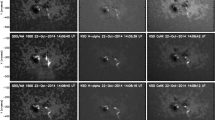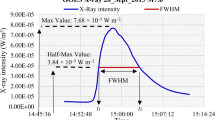Abstract
We analyzed the dynamics of the reconnection and energy release processes of the X2.2 and X9.3 flares that occurred on September 6, 2017 in the active region NOAA 12673. We used SDO/AIA 1600 Å images together with SDO/HMI magnetograms. As a proxy for the flare energy release rate, we used the KRIM and RSTN microwave time profiles, GOES soft X-rays and its time derivative. Assuming that the chromospheric flare ribbons are located at the footpoints of magnetic field lines reconnecting in the corona and that the magnetic flux is conserved from the photosphere to the corona, we obtained magnetic reconnection fluxes and rates of its change. The cumulative positive and negative magnetic fluxes involved in the reconnection process were balanced. Temporal correlations are found between the calculated reconnection rate and the observed microwave emissions from for both events. An analysis of the total cumulative magnetic flux and SXR fluence of events showed that the magnitude of the magnetic flux involved in the reconnection process was greater in more energetic events and less in weaker ones.




Similar content being viewed by others
REFERENCES
Asai, A., Kiyohara, J., Takasaki, H., et al., Temporal and spatial analyses of spectral indices of nonthermal emissions derived from hard X-rays and microwaves, Astrophys. J., 2013, vol. 763, p. 87. https://doi.org/10.1088/0004-637X/763/2/87
Cornell, M.E., Hurford, G.J., Kiplinger, A.L., and Dennis, B.R., The relative timing of microwaves and hard X-rays in solar flares, Astrophys. J., 1984, vol. 279, pp. 875–881. https://doi.org/10.1086/161958
Dennis, B.R. and Zarro, D.M., The Neupert effect: What can it tell us about the impulsive and gradual phases of solar flares, Sol. Phys., 1993, vol. 146, pp. 177–190. https://doi.org/10.1007/BF00662178
Forbes, T.G., Linker, J.A., Chen, J., et al., CME theory and models, Space Sci. Rev., 2006, vol.123, pp. 251–302. https://doi.org/10.1007/s11214-006-9019-8
Gopasyuk, O.S., Volvach, A.E., and Yakubovskaya, I.V., Magnetic reconnection rates in a confined X class flare, Geomagn. Aeron. (Engl. Transl.), 2022, vol. 62, no. 7, pp. 888–894. https://doi.org/10.1134/S0016793222070106
Guidice, D.A., Cliver, E.W., Barron, W.R., and Kahler, S., The air force RSTN system, Bull. Am. Astron. Soc., 1981, vol. 13, p. 553.
Hu, Q., Qiu, J., Dasgupta, B., et al., Structures of interplanetary magnetic flux ropes and comparison with their solar sources, Astrophys. J., 2014, vol. 793, p. 53. https://doi.org/10.1088/0004-637X/793/1/53
Isobe, H., Takasaki, H., and Shibata, K., Measurement of the energy release rate and the reconnection rate in solar flares, Astrophys. J., 2005, vol. 632, pp. 1184–1195. https://doi.org/10.1086/444490
Jing, J., Qiu, J., Lin, J., et al., Magnetic reconnection rate and flux-rope acceleration of two-ribbon flares, Astrophys. J., 2005, vol. 620, pp. 1085–1091. https://doi.org/10.1086/427165
Kundu, M.R., Schmahl, E.J., and Velusamy, T., Magnetic structure of a flaring region producing impulsive microwave and hard X-ray bursts, Astrophys. J., 1982, vol. 253, pp. 963–974. https://doi.org/10.1086/159694
Lemen, J.R., Title, A.M., Akin, D.J., et al., The Atmospheric Imaging Assembly (AIA) on the Solar Dynamics Observatory (SDO), Sol. Phys., 2012, vol. 275, pp. 17–40. https://doi.org/10.1007/s11207-011-9776-8
Miklenic, C.H., Veronig, A.M., and Vršnak, B.A., Temporal comparison of nonthermal flare emission and magnetic-flux change rates, Astron. Astrophys., 2009, vol. 499, pp. 893–904. https://doi.org/10.1051/0004-6361/200810947
Neupert, W.M., Comparison of solar X-ray line emission with microwave emission during flares, Astrophys. J., 1968, vol. 153, p. L59. https://doi.org/10.1086/180220
Qiu, J. and Yurchyshyn, V.B., Magnetic reconnection flux and coronal mass ejection velocity, Astrophys. J., 2005, vol. 634, pp. L121–L124. https://doi.org/10.1086/498716
Qiu, J., Wang, H., Cheng, C.Z., and Gary, D.E., Magnetic reconnection and mass acceleration in flare-coronal mass ejection events, Astrophys. J., 2004, vol. 604, pp. 900–905. https://doi.org/10.1086/382122
Qiu, J., Hu, Q., Howard, T.A., and Yurchyshyn, V.B., On the magnetic flux budget in low-corona magnetic reconnection and interplanetary coronal mass ejections, Astrophys. J., 2007, vol. 659, pp. 758–772. https://doi.org/10.1086/512060
Schou, J., Scherrer, P.H., Bush, R.I., et al., Design and ground calibration of the Helioseismic and Magnetic Imager (HMI) instrument on the Solar Dynamics Observatory (SDO), Sol. Phys., 2012, vol. 275, pp. 229–259. https://doi.org/10.1007/s11207-011-9842-2
Temmer, M., Veronig, A.M., Vršnak, B., and Miklenic, C., Energy release rates along Hαflare ribbons and the location of hard X-ray sources, Astrophys. J., 2007, vol. 654, pp. 665–674. https://doi.org/10.1086/509634
Veronig, A.M. and Polanec, W., Magnetic reconnection rates and energy release in a confined X-class flare,Sol. Phys., 2015, vol. 290, pp. 2923–2942. https://doi.org/10.1007/s11207-015-0789-6
Veronig, A., Vršnak, B., Dennis, B.R., et al., Investigation of the Neupert effect in solar flares. I. Statistical properties and the evaporation model, Astron. Astrophys., 2002, vol. 392, pp. 699–712. https://doi.org/10.1051/0004-6361:20020947
Volvach, A.E. and Yakubovskaya, I.V., Diagnostic complex of solar activity based on small radiotelescopes of the Sun service KRIM, Astron. Astrophys. Trans., 2019, vol. 31, no. 3, pp. 389–398.
ACKNOWLEDGMENTS
SDO is a project of the NASA Living with a Star program. SDO/AIA and SDO/HMI data were provided by the Joint Science Operation Center (JSOC).
Funding
This work was supported by ongoing institutional funding. No additional grants to carry out or direct thisparticular research were obtained.
Author information
Authors and Affiliations
Corresponding author
Ethics declarations
The authors declare that they have no conflicts of interest.
Additional information
Publisher’s Note.
Pleiades Publishing remains neutral with regard to jurisdictional claims in published maps and institutional affiliations.
Rights and permissions
About this article
Cite this article
Gopasyuk, O.S., Volvach, A.E. & Yakubovskaya, I.V. Magnetic Reconnection Flux during Two Flares on September 6, 2017. Geomagn. Aeron. 63, 1000–1006 (2023). https://doi.org/10.1134/S0016793223070095
Received:
Revised:
Accepted:
Published:
Issue Date:
DOI: https://doi.org/10.1134/S0016793223070095




